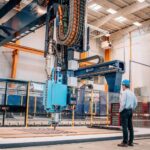April 9, 2018 – Back in 2015 I read a 52-page essay about the 24th century’s view of our handling of climate change in the 20th and 21st. Obviously a work of fiction, it described how initially the rise in atmospheric greenhouse gases was not linked to human activities until the 1970s. And then when climate scientists verified that we were the causal agent of atmospheric warming, some attempts were made to begin to reign in our carbon generating economic activity. But climate change skeptics, many from industries and lobby groups who felt most impacted by carbon reductions inhibited progress in implementing a low-carbon transition. The result, by the mid-21st century a succession of rising temperatures, increasing extreme weather events and accelerating sea-level rise led to attempts at geoengineering a variety of planet-cooling solutions.
One solution was to remove carbon from emission sources. That meant putting expensive carbon-capturing technology in place in manufacturing facilities and power plants. Another solution was to try and draw carbon out of the ambient air continuously in the same way plants do it using artificial photosynthesis and complex filtering systems. Taking stuff out of the atmosphere seemed like a good way to draw down on the carbon our industrial society was producing.
But then there were those who didn’t want to add complexity to industrial plants and power generation. Rather they wanted to leave industry as is and attempt to manipulate the atmosphere by adding even more chemistry to it in the form of aerosol spraying to cool the Earth in the same way volcanic eruptions do. Others thought that seeding to create more clouds would serve the same purpose. And then there were the even more ambitious who wanted to put satellites in Earth orbit with large reflecting mirrors to bounce sunlight away from the Earth’s atmosphere and thus lowering its temperature.
In the fictional account of our human experiment in geoengineering, tinkering with the atmosphere led to unintended consequences. Much of western North America suffered from extensive and prolonged droughts leading to a new Dust Bowl in the American Midwest. Africa and Australia became even drier. And India and South Asia saw the annual monsoon come to an end. The Amazon rainforest, the single most important biome of our planet was disrupted leading to massive deforestation. Famine followed drought. Nations collapsed.
The story is a work of fiction yet there are disturbing parallels in the current path humanity is taking to address the growth of carbon in our atmosphere problem. No longer fiction, since 2013 the United States and a number of other governments are seriously investigating geoengineering solutions to climate change.
In January of 2017, the American government’s strategic plan on the climate acknowledged that rapid changes were happening to the global climate and suggested a number of actions. Among these were experiments to reflect sunlight and produce atmospheric cooling, described as albedo modification by the experts who contributed to the report.
Not familiar with the reference to albedo, it refers to the ability of an object to reflect sunlight. For instance, ice and snow have a high albedo effect. Forests and the ocean have a low albedo effect. Painting rooftops white increases their albedo effect. Leaving them dark does not.
As early as 2015 the U.S. Department of Energy, NASA, NOAA and the National Academy of Sciences were all into studying ways to reflect sunlight to cool the Earth. Thought of as a last-ditch effort to save the planet, it appears that last ditch is moving up to becoming more like the first ditch.
There is geoengineering and then there is GEOENGINEERING. Painting rooftops white to cool city environments and reduce the heat island effect is the lowercase version of the field. Seeding the stratosphere with an army of jets spewing out aerosols is geoengineering in upper case. We have no idea of the unintended consequences of such acts. Nor do we understand what will happen if we use satellites to reflect sunlight away from the Earth.
Here is a future scenario that has horrific consequences. We continue to raise the carbon atmosphere load to 500 or more parts per million. To compensate we put a series of satellites in orbit that act like giant sunshades. Something happens to one or more of the satellites and suddenly we have no cooling shield. What would be the consequences? Sudden temperature spikes? More extreme weather than what we have previously experienced? Devastation to crops?
The kind of geoengineering that can work takes stuff out of the air and puts it away permanently either by burying it or turning it into growing things or into materials we can use.
For Canada, we are fortunate to be on the leading edge of sequestering carbon with interesting technologies already in place. Our problem as a nation is our lack of salesmanship in getting the world to understand what we are creating here. Whether we are talking about Boundary Dam and the sequestration of carbon from a coal-burning thermal power plant in Saskatchewan, to the Shell Quest project in the Alberta oil sands, sequestering carbon from bitumen production processes, or Carbon Engineering‘s technology that harvests carbon dioxide directly from the air, or CO2 Solutions with an enzymatic process to extract carbon at industrial plants, Canada has the net-negative emission goods to sell to the world. And although these technologies are expensive right now because the initial price includes the costs of engineering as well as all the research and development, the designers already have indicated they can streamline processes and production, and scale can further reduce the cost to make these technologies attractive to every country that is a signatory to the Paris Climate Agreement.
With the window closing on keeping atmospheric warming at no more than 2.0 Celsius (3.6 Fahrenheit), and better yet, no more than 1.5 (2.7 Fahrenheit), there should be a sense of urgency to make these made-in-Canada geoengineering solutions available. The tens of thousands of jobs that can be created from these negative emission technologies cannot be dismissed by business or government.
As for geoengineering that adds more complexity to our atmosphere through seeding, or that shields our atmosphere from the sun, I have serious concerns should these projects get green-lighted by any country. I state this because, in the media in the last few weeks, there have been commentaries written suggesting that developing nations should collectively invest in sunshade geoengineering projects because they will be most impacted by climate change. This, in my opinion, could be potentially disastrous for the planet.
















